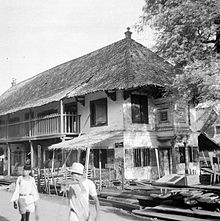Jamiat Kheir
[1] The permit took two years to be granted by the government, where it then was issued in 1905, after Muḥammad bin ʻAbdurrahman al-Mash-hoor as the secretary of Jamiat Kheir sent a letter clarifying the intent and purpose of the establishment of the association on March 16, 1905.
[1] On June 17, 1905, Jamiat Kheir as an organization was officially authorized by the Governor General of the Dutch East Indies and its Articles of association were also approved.
[3] The official license issued by the Dutch government was based on the input from Priesterraden, a special body set up in 1882 with the task of overseeing religious and Islamic education.
Soon after the permission was obtained, the Jamiat Kheir opened an elementary level (Ibtidaiyyah) madrasa in Pekojan which provided free education, using a curriculum blend of religious studies and general subjects.
In addition, the number of members of the Jamiat Kheir also increased, among them are imams of the mosque, teachers, employees, village headmen or others.
Being aware of government suspicion and its suppressions, Jamiat Kheir then took a strategy to change its Article of association again, especially in matters of education.
Because Jamiat Kheir as a social organization had been suspected by the government due to its political activities, then on October 17, 1919, it amended its Article of association and became an education foundation.
On the date, Jamiat Kheir became the Education Foundation of Jamiat Kheir based on the new dated October 17, 1919 which was recorded in the notary deed number 143, STICHTINGSBRIEF de STICHTING "SCHOOL DJAMEAT GEIR" (The Deed of Djameat Geir School), by Jan Willem Roeloffs Valk[4] in Batavia.
47, the Dārul Aytam (literally means House of orphans) orphanage was established by notarial deed of Dirk Johannes Michiel de Hondt (1886-1945)[5] No.
The limited liability business Setija Oesaha was established and headquartered in Pabean sub-district, Pesayangan in Surabaya and the operation was entrusted to HOS Tjokroaminoto who served as the director.
Later time, it built the orphanage Dārul Aytam which is dedicated to treating and educating orphans in Tanah Abang, Central Jakarta, which until now is still active.
On the basis of Islamic brotherhood, Jamiat Kheir helped financially to victims of the war in Tripoli, and built the Hejaz Railway connecting the city of Medina with the areas around the strip of Sham and others.
Since the Jamiat Kheir's publications were distributed widespread, news about intimidations carried out by the Dutch government heard internationally and got enough attention.
The pressure and intimidation from the Dutch East Indies to the Jamiat Kheir instead created stronger ties of brotherhood between Arabs and indigenous Indonesian society.
The organization must be led by Indonesian noblemen to imitate the Jamiat Kheir whose many of the indigenous students were aristocratic Javanese, such as Ahmad Dahlan who later became the founder of Muhammadiyah.
His mother is Muznah binti Said Naum, the daughter of the land endowment (Arabic: الوقف التربه, romanized: al-Waqf al-Turbah) foundation founder Shaikh Said Na'um.
The school board of Jamiat Kheir, having noticed that the facility in Pekojan could no longer able to accommodate the flow of prospective students which increased every year, excited to find a new larger location.
Initially they planned to move Jamiat Kheir from Pekojan to a new location on Karet Weg street in Tanah Abang, but because the venue was planned for a hospital by the Dutch government (now it is occupied as the Puskesmas of Tanah Abang), with the initiative of Abūbakar bin Muḥammad al-Habshi (the Chairman of the board) in 1923, the Foundation bought a new 3,000 square metres (32,000 sq ft) land for the school.
On March 26, 1929, the foundation made another attempt to buy a 2,500 square metres (27,000 sq ft) plot of land in Kebun Melati which later used as girls-only Elementary School.
[7] Because there was the law forbidding Jamiat Kheir to open school branches in other cities with the same name, people then established schools with different names (although sametimes similar, especially in Arabic) but with the same spirit and most of them affiliated with the Jamiat Kheir in Batavia, such as al-Jamʻiyyah al-Khairīyah al-ʻArabiyah in Ampel, al-Mu’awanah in Cianjur, al-ʻArabiyah al-Islamiyah in Banyuwangi, and Shama'il Huda in Pekalongan.
Surkati's first two years at this position was a great success, creating an assurance for the Jamiat Kheir to hire four more foreign teachers in October 1913.
They all joined Aḥmad Surkati in Batavia except Shaikh Muḥammad al-'Aqib who launched a new Jamiat school branch in Surabaya.
It became more serious in 1913 when Surkati was asked during his visit to Solo during school holidays about his opinion on a marriage between a Sayyid woman with a non-Sayyid man.
Surkati suggested that money should be collected from among the local Haḍramis in order to release her from such a shameful circumstance which was apparently driven by economic hardship.
When the objection was put that her marriage to a non-Sayyid would be illegal on the basis of Kafa'ah, he argued it would be legal according to a reformist interpretation of Islamic law.
His opinion was quickly heard by the Jamiat Kheir leaders in Batavia, causing his relationship with the more conservative Sayyids deteriorated rapidly.
A rebuttal was even written by ʻAbdullah al-Aqib, one of Surkati's student, with the title of al-Khitab Faṣl fi Taʻyid al-Sūrah.
Further arguments written by Surkati and supporters eroded out by the book published in 1926 entitled al-Qaul al-Faṣl fī mā li Bani Hāshim wa Quraish wa al-Arab min al-Faḍl written by Mufti of Johor ʻAlwi bin Țahir al-Haddad.
Surkati then wrote his arguments and answers in Al-Masa `il ats-Tsalats in 1925 which contained the issue of Ijtihad, Bid‘ah, Sunnah, Heresy, Ziyarat (visiting graves), Taqbil (kissing the hands of Sayyids)[15][16] and Tawassul.
The first student financed by the al-Rabiṭah to graduate from Jamiat Kheir was Sharifah Qamar of Darul Aytam, where she received stipend of 15 guilders a month.







